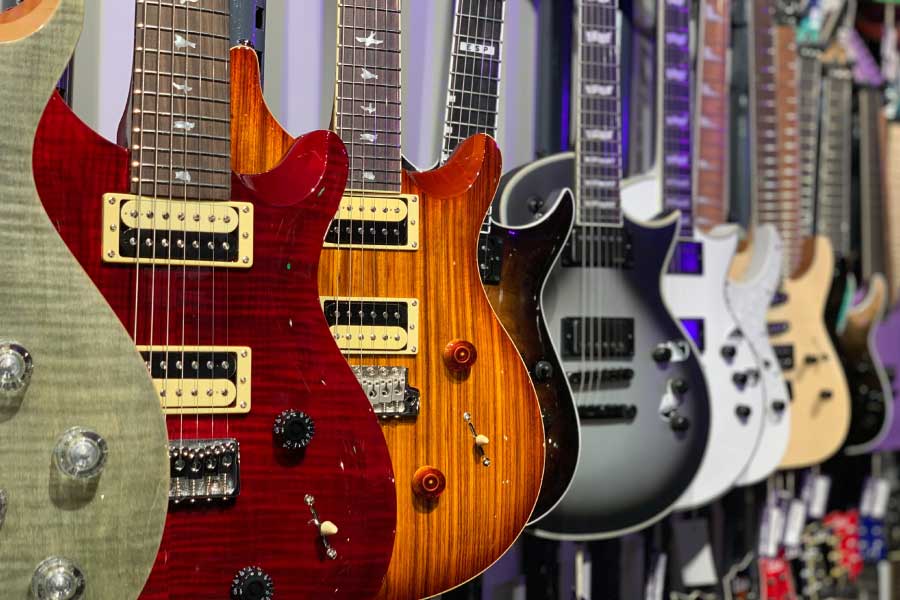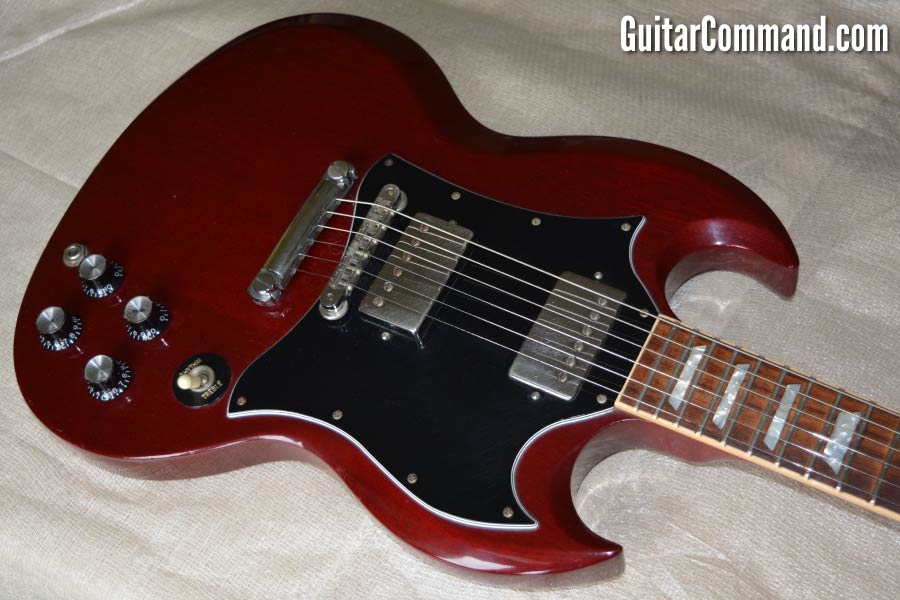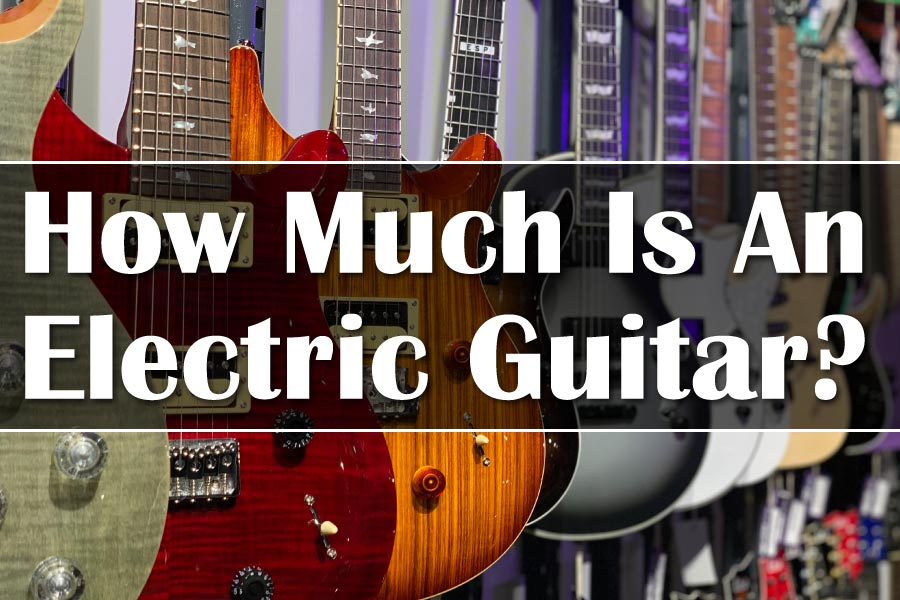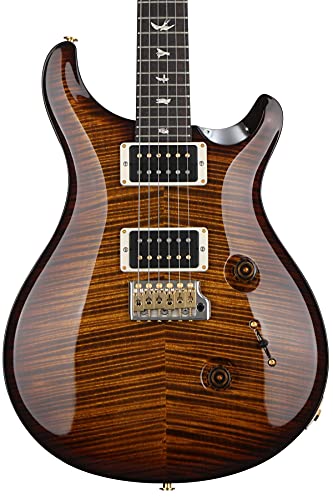How Much Is An Electric Guitar?
A new electric guitar can cost anything from $99 to five-figures plus. Expect to pay around $199 to $399 for a good beginner electric guitar; around $400-$799 for an intermediate instrument; and $800-$1,500+ for a dependable, professional-quality recording and gigging guitar. At $1,500 and above, you can expect the highest-quality, high-end instruments.
Guide To Electric Guitar Prices

Buying a new guitar is just about the most exciting thing you can do as a player, except maybe playing shows! However, whether you’re an absolute beginner or a seasoned pro, buying a guitar is always a balancing act between your needs and your budget.
To help you with your big decision, we’ve put together this handy guide to how much you should spend on an electric guitar.
On this page, we’ve concentrated on solid-bodied electric guitars. Hollow-bodied and archtop electric guitars are more complex to build, and relatively specialized. As a result, they're (generally) more expensive.
You can find out more about the different types of electric guitar on this page: Types Of Electric Guitars
Page Index
How Much Is A Beginner Electric Guitar?
Example Beginner Electric Guitars
How Much Is An Intermediate Electric Guitar?
Example Intermediate Electric Guitars
How Much Is A Professional Electric Guitar?
Example Professional Electric Guitars
How Much Is A High-End Electric Guitar?
Example High-End Electric Guitars
Electric Guitar Price
While the salesman at your local guitar store will probably try and get you to spend more, the reality is that you need a guitar to suit you.
If you’re a beginner, you probably shouldn’t be spending thousands of dollars on a high-end, custom shop instrument.
A good $200 to $400 electric guitar–perhaps something like the Yamaha Pacifica PAC012 (click to view on Amazon)–will be perfectly adequate at this stage of your playing career (and will likely serve you well at least until you start gigging more than a few times each month).
Likewise, if you’re a working professional, that Squier Stratocaster (click to view on Amazon) at the guitar store – while a great guitar for a beginner – probably won’t quite cut it. The tuning stability, sustain and intonation may not meet the standards you require if you make a living with your guitar.
- Thin and lightweight body
- Three Squier single-coil pickups
- 2-point tremolo bridge
- Slim and comfortable “C”-shaped neck profile
- Sealed die-cast tuning machines with split shafts
There are plenty of phases of your guitar journey in between being a total beginner and seasoned pro, and there are guitars aimed at every step of that journey.
There are also a variety of non-US manufacturers that built top-tier instruments for a fraction of the price of US companies (we’ll take a look at a few of these in the list below).
We’ve broken the massive electric guitar market down into four categories:
How Much Is A Beginner Electric Guitar?
- Expect to pay between $199 and $399 for a good beginner guitar
- Most major brands provide entry-level options (e.g., Fender’s Squier range, and Gibson’s Epiphone range)
- Several guitar brands offer beginner packs that include an amp and accessories. These can be a good choice if you haven’t already got these items. (An example is this Squier Affinity Stratocaster Bundle - click to view at Amazon.)
- Guitars in this price range are usually mass-produced using inexpensive materials
- You can “pay for the name” for US brands at this level. Guitars by well-respected non-US companies such as Yamaha and Ibanez may offer better value than their US counterparts.
When you’re just starting out on guitar, you probably won’t know (or care) much about different tonewoods, electronics, and other components; you just want an instrument that is easy to play, sounds great, and looks good.
Generally speaking, beginner electric guitars are mass-produced with inexpensive woods and hardware.
Cheap should not mean unreliable, however. You want an instrument that stays in tune, is relatively easy to play, and has the capacity to be set up to play well.
Luckily, most guitar manufacturers realize this, and provide models that are suitable for the needs of most beginners.
Below are some examples of well-regarded beginner electric guitars.
Don't forget that you'll also need both an amplifier and a lead (to connect the guitar to the amp), in order to produce a useable sound. Several manufacturers (and stores) produce beginner bundles that contain these and other useful items.
Example Beginner Electric Guitars
Yamaha Pacifica PAC012/100 Series
The cheaper models in Yamaha’s Pacifica range are great beginner guitars. They’ll set you back between around $200 and $299, depending on pickup configuration and other hardware details.
Ibanez GRG Series
- Grew Maple neck
- 24 Frets
- High output ibz-6 pickups
There’s an Ibanez RG guitar to suit all budgets. The Gio models may lack the features of guitars in the RG Prestige range, but they’re solid instruments that are perfect for a beginner. Prices are around $249, depending on features.
Squier Stratocaster
- Thin and lightweight body
- Three Squier single-coil pickups
- 2-point tremolo bridge
- Slim and comfortable “C”-shaped neck profile
- Sealed die-cast tuning machines with split shafts
Countless guitarists have begun their musical journeys with a Squier guitar. Squier produce beginner versions of most popular Fender guitars; we'd recommend a Stratocaster, as it's arguably the most versatile guitar in the Fender range.
Squier Beginner Electric Guitar Pack
Several excellent Squier beginner packs are available at around the $350 mark. They include a Fender Frontman amplifier (which is a great amp, by the way), lead, and other accessories.
- Adjust tone intensity with a simple controller knobs, for volume, treble and bass
- Add cool music effects by using the standard tremolo arm
- Experience warm, balanced sound with the humbucking pickup in bridge position
- Smooth and easy tuning with sealed die-cast tuning machines with split shafts
- Included Fender Frontman 10G amplifier delivers full sound from its 6" speaker, with a gain control and overdrive switch that rock guitar tones from tube-emulated overdrive to full-strength ultra-saturated distortion - perfect for blues, metal and famous Fender clean tone
Should I Buy An Expensive Guitar As A Beginner?
There's no reason why you shouldn't spend a little more on a guitar, and a guitar salesman will be only too happy to help you to do so!
In general, you get what you pay for. A more expensive instrument will likely be better built, be equipped with better hardware, and even be easier to play.
However, you should be very sure that playing guitar is not just a passing phase; you might regret spending your life savings on a guitar if you subsequently decide that the instrument is not for you! (An electric guitar can be an expensive ornament!)
How Much Is An Intermediate Electric Guitar?
- Expect to pay between $400 and $850 for an intermediate level electric guitar
- Intermediate guitars are more reliable and fitted with better hardware than guitars aimed at complete beginners
- Mass produced, but with better materials
- Buying second-hand can be a great option at this (and any other) price point
After you’ve been playing guitar for a while you might have begun to realize the shortcomings of your beginner instrument. Perhaps the pickups aren’t quite producing the tones you want, or the tuning is less stable than you’d like.
At this point, you’ll want to start looking at higher-quality instruments. However, if you aren’t gigging regularly or seeing any money from music, then you might not want to sell the family farm in order to get your hands on a top-of-the-line guitar.
You might also want to set some money aside for upgrading your amp or effects. If you’re living in student accommodation or playing in garage bands, it's likely that your guitar might pick up a few knocks or other “war-wounds”; you might not want to be taking care of a $1000+ guitar when something cheaper will do much the same job.
Example Intermediate Electric Guitars
Ibanez RG Standard
- Wizard III Maple neck Ash body Maple fretboard w/Black dot inlay Jumbo frets Quantum (H) neck pickup Quantum (H) bridge pickup Fixed bridge Cosmo Black Hardware
- The RG421AHM features an ash body sparkling highs and beefy lows, and it’s complemented by the distinction of a maple fretboard, which, as tone aficionados know well, yields a shade more “bite” to the guitar’s voice
- As the originators of the thin, fast neck, the Wizard III is yet another achievement in player comfort—comfort that translates into maximizing player performance
- A pair of proprietary Quantum pickups produces an entire palette of thick, distorted tone textures that offer exceptional high-end articulation
- A simple, yet solid fixed bridge provides stable, dependable tuning and accurate intonation
A mid-range Ibanez RG offers arguably more value for money than its Fender / Gibson equivalents (and possibly better build quality, too). From $400 up you’ll be able to get an RG Standard that will stand you in good stead both on stage and in the studio.
Towards the upper end of the “intermediate” price range, the Japanese company offers guitars that will serve you well wherever your musical career takes you.
PRS SE 24
- Solidbody Electric Guitar with Mahogany Body
- Vibrato Bridge - Translucent Blue
- Rosewood Fingerboard
- 2 Humbucking Pickups
- Maple Neck
Paul Reed Smith (PRS) is an American manufacturer known for their high-end models. In 2000, the company added the SE range of more affordable guitars, aimed at students and intermediate players.
Worth checking out is the SE Standard 24, which is a beautiful-looking guitar based on the company’s flagship Custom 24 (see the “High End” section of this article to find out how much one of those will set you back!).
Fender Player Series
- Alder Body with gloss finish
- Two player Series single-coil Telecaster pickups
- Modern C"-Shaped neck profile
- 9. 5"-Radius Fingerboard
- String-through-body Bridge with block saddles
The recent resurgence of Fender electric guitars in popular music is testament to just how versatile their instruments are.
At the top of the “intermediate” level (and pushing into the “pro” level), are the guitars in Fender’s Player range.
The Fender Player Telecaster, retailing at around $849.99, is a popular intermediate-level guitar. You’ll hear characteristic Telecaster twang on recordings in just about every genre.
Country, jazz, blues, rock, and even hard rock and metal artists have recorded using the Telecaster. This guitar’s alder body and twin single-coil pickups sound great, and its comfortable C-shaped neck profile will make practicing and jamming a lot of fun.
EVH Wolfgang Standard
- Solidbody Electric Guitar with Basswood Body
- Floyd Rose Tremolo - Natural Ziricote
- Baked Maple Fingerboard
- 2 Humbucking Pickups
- Baked Maple Neck
If your tastes lean heavier, then look no further for an intermediate guitar than EVH’s Wolfgang Standard. This guitar is built in Mexico in a factory owned by Fender guitars.
It retails at around $749.99 (depending on color / finish) and features an ultra-lightweight basswood body, easily adjustable action, a locking tremolo system and two awesome EVH-brand humbucker pickups.
This is arguably the best bang-for-buck “shred” guitar out there, as it uses all the same electronics and hardware as the more expensive EVH offerings, but at a far more accessible price point.
This guitar isn’t just for metalheads, though - even Taylor Swift’s guitar player uses an EVH Wolfgang, because they sound just as good through a clean amp as with a dirty one.
How Much Is A Professional Electric Guitar?
Quick Guide
- Expect to pay $850 to $1,500+ for a professional electric guitar
- Guitars in this price range are best for musicians who gig at least a few times per month or who make professional-level recordings
- Guitars at this price point are dependable, “workhorse” guitars, suitable for frequent use
- You can “pay for the name” with certain U.S. brands. However, high-end Fenders, Gibsons, etc. will likely hold their value better than less-established brands.
While any of the guitars featured in the intermediate section of this article would undoubtably serve you well in most professional situations, if you’re making a living with your playing you don’t want to be cutting any corners with your gear.
Here, we’re looking at guitars for working musicians. You might not be a full-time pro yet, but you’re playing often enough to need an instrument that can stand up to regular practice and time spent both on-stage and in the studio.
Example Professional Electric Guitars
Ibanez Prestige Range
- 2 Fishman Fluence Humbucking Pickups - Burgundy Metallic Flat
- Solidbody Electric Guitar with African Mahogany Body
- Macassar Ebony Fretboard
- Maple/Wenge Neck
Ibanez’s Prestige line is aimed squarely at the pro market. The Ibanez RG5121, for example, retails at around $1,799.99. It uses humbucking pickups, and has solid mahogany and maple construction.
Its beautiful ebony fretboard is hard enough to stand up to frequent playing, and its humbucking pickups will produce fierce metal tones as well as clean jazz sounds.
We actually saw a wedding band player using this guitar to cover everything from Bon Jovi to Motown!
The RG Prestige range includes several other body / fingerboard material combinations.
Fender American Professional II Series
No products found.
Definitely in the "pro" category are Fender’s American Professional II series Stratocasters, which start at around $1,700.
Built in the USA with high-quality Fender parts, these guitars won't let you down.
Gibson SG

Gibson electric guitars traditionally cost more than Fenders, probably due to their more complex design. The SG, however, is a relatively simple guitar, and is available for under $2,000.
You could also get a Les Paul Studio / Standard / Junior for this type of money, but (for us) this seems like a big compromise compared to a “real” Les Paul.
How Much Is A High-End Electric Guitar?
Quick Guide
- There is no price ceiling on high-end guitars. Expect to pay at least $1,500, and probably more!
- Best for working guitarists making a good income from music (or wealthy amateurs / collectors)
- Even pro players can be hesitant to take a $2,000+ guitar to each and every gig they play
- High-quality materials, construction, and usually aimed at a specific genre or type of player
- Often uses either cutting-edge tech or authentic vintage hardware
High-end guitars are aimed at two types of person: professional musicians, or (more often than not) amateurs with big wallets!
If you’re looking for a high-end guitar, you probably know the type of music you like to make, and what you’ll need from a guitar.
Often, working musicians have multiple high-end guitars on hand for a variety of gigs.
Example High-End Electric Guitars
Gibson Les Paul

One of the archetypal rock guitars, the Les Paul has long been one of the most desirable of all "traditional" electric guitars.
Sadly, today, the price of a Les Paul puts it out of the reach of most players; even gigging professionals are hesitant to take a $2,000+ guitar to most gigs.
PRS Custom 24
- Solidbody Electric Guitar with Mahogany Body
- 2 Humbucking Pickups - Black Gold Wrap Burst
- Rosewood Fingerboard
- Mahogany Neck
- Maple 10-Top
The Custom 24 is US guitar manufacturer PRS's flagship model. It is a gorgeous-looking guitar, with playability and tone to match. It's also a flexible beast, able to supply the tone you need to play a wide range of musical styles.
Of course, this level of luxury doesn't come cheap. Expect to pay over $4,500 for one of these beauties.
Upgrading Vs Buying A New Guitar
It’s worth noting that even inexpensive guitars can be massively improved with a few simple upgrades.
Legendary Guns N’ Roses guitarist Slash, for example, delivered all the iconic guitar parts on Appetite for Destruction using a cheap Les Paul copy, which he upgraded with Seymour Duncan pickups.
A good setup, proper intonation, and upgrades to electronics and hardware can massively improve a cheap guitar.
Of course, by the point at which you’ve paid for all these hardware upgrades, you may as well have spent the money on a more expensive guitar built by professionals. However, upgrading does give you the choice to improve your guitar incrementally, without a single large payment. You’ll also end up with a guitar that is custom-made to your needs.
Second-Hand Electric Guitars
It’s also worth pointing out that, these days, the second-hand guitar market is thriving, particularly online. You can find bargains pretty much anywhere, but particularly on eBay and your local buy/swap/sell pages.
A new guitar has lost around 25% of its value as soon as you walk out of the shop with it. If you’re lucky, it may become collectable in a decade or so, but until then its price will only go one way.
By buying second-hand, you could feasibly sell your guitar for the same price (or more) than you bought it for. This may be something to bear in mind if you’re at the beginning of your playing career, or if you’re a parent buying for a child.
Conclusion
Hopefully this guide to electric guitars and their prices helped you in your journey. Buying a new guitar should be an exciting and rewarding process no matter your skill level, and we hope you find the best guitar for your needs in our list.












